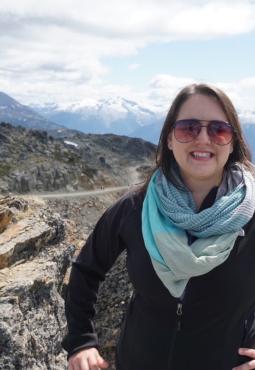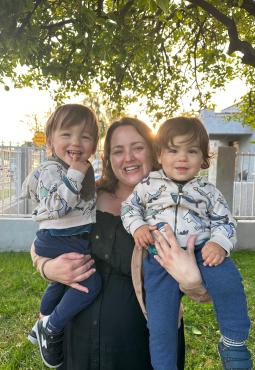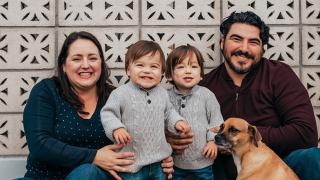Robin Watkins calls herself a “connector,” someone who specializes in bridging gaps and bringing people together through collaboration and community. It’s a trait she exhibited early on, holding many student government positions during her school years, and it serves her well now, as a social and content account director for an advertising agency in Playa Vista, California.
“I specialize in relationship-building,” she says. “And I like leading a team and mentoring the next generation.”
At home, she has her own “next generation” to keep her busy. She and husband Edgar Molina are the proud parents of 2-year-old twin boys, Mateo and Nicolas. Watkins refers to the twins in an interesting way.
“My boys saved my life,” she says.
Spotted on Ultrasound
Back in 2017, Watkins, then 34, was trying hard to become a mother, making the rounds of fertility specialists. As part of the process, she went for an ultrasound. The doctors didn’t like what they saw on the screen.
“There was something on the right ovary,” she recalled. This puzzled and worried her. She had no symptoms; she had always been active and healthy. There was no ovarian cancer in her family. Perhaps it was just a benign cyst, as many turn out to be?

A blood test added to her anxiety. Watkins’ CA 125 level (a measurement of a specific protein that may indicate cancer) was “off the charts.” A normal level is 35 or below; Watkins’ spiked at 400.
An MRI (magnetic resonance imaging) scan confirmed the mass and convinced Watkins that she needed to see a cancer specialist right away.
She tried to make an appointment close to home but could not be accommodated quickly. That’s when family, friends and social media came to her aid. Watkins’ sister, who works in the health field, reached out to her online network of friends and colleagues, one of whom helped connect Watkins with City of Hope. Within days, she was on the Duarte campus for her first visit.
Though grateful to be seen so quickly, a deep fear began to well up inside her. If this was cancer, and if she needed surgery, all of her efforts to have a child could be in vain. “I remember the tears,” she said.
The doctor seated across from Watkins understood.
“She really wanted to have children,” recalled Thanh H. Dellinger, M.D., associate professor in the Division of Gynecologic Oncology, Department of Surgery. But Dellinger determined that the ovarian mass needed to be removed surgically. Only then could a pathologist determine for certain if it was cancerous. (A biopsy was not recommended, Dellinger explained, as the mass could rupture and spread cancer cells throughout the abdominal area.)
For women past childbearing age, and for patients with advanced ovarian cancer, surgery usually means the removal of the uterus as well as the ovaries. Dellinger looked at the young woman before her and offered an alternative: fertility-sparing surgery in which the uterus is preserved, so the patient, even if she can no longer conceive, can still carry a child.
Dellinger urged Watkins to return to her fertility specialist and complete the in vitro fertilization (IVF) process — creating embryos that could later be implanted. Watkins liked the plan and appreciated the empathetic physician who was listening to her concerns.
“She was very professional, really good at laying it all out,” Watkins said of Dellinger. “I wasn’t being coddled. She gave me peace of mind from a scientific standpoint. I never went for a second opinion. I trusted her word.”
Dellinger says that’s simply the “bedside manner” she’s employed since joining City of Hope a decade ago.

“This is my way of communicating,” she explained. “I give my patients all the information they need. I want them to make an educated decision. Patients come from all different backgrounds, and not all want to hear every last detail. But Robin wanted all of it. We matched well. She’s a lovely person.”
They put the plan into action. Watkins’ IVF yielded three viable embryos. Now she was ready for her surgery.
Outwardly she kept up a brave front, continuing to work (“I was doing client shoots all through this,” she said) as her surgery date approached. But as she was taken to the operating room, the reality of her situation sank in.
“I thought to myself,” she recalled tearfully, “just let them take out whatever they need to.” She was scared, and she wanted to live. She also resolved to release the things she could not control. “I learned not to get ahead of myself, to go with the information I had, not the information I didn’t have yet. When you stay focused on what you know, you’re empowered. If you dwell on what you don’t know, you’re powerless.”
Good News, Bad News
Dellinger performed a robot-assisted procedure to remove the mass, one ovary, one fallopian tube and dozens of lymph nodes. The pathology report carried good news and bad news. Some lymph nodes displayed “atypical” cells. This meant Watkins technically had Stage 3 disease. “That was a bit jarring to hear,” said Watkins.
Dellinger, however, reassured her. The tumor itself was classified as “borderline,” meaning it was not an aggressive malignancy. It also meant Watkins would not need chemotherapy or radiation.
“A Stage 3 borderline tumor of the ovary is not typical,” said Dellinger. Nevertheless, survival rates are excellent. But Dellinger did counsel Watkins to wait a full two years before attempting a pregnancy because of the possibility of a recurrence.

A year later, that’s what happened. Two blueberry-sized growths were detected on Watkins’ remaining ovary. More surgery would be necessary. “This was much harder for me emotionally,” recalled Watkins of losing her second ovary and fallopian tube. “I began to think it would never be safe to get pregnant, and I began to mourn the loss of the possibility of having a child.”
But then, more good news.
The second surgery took place in April 2019. The newly found masses were still in the “borderline” category, meaning the cancer had not advanced to a more malignant state. Once again, Watkins did not need radiation or chemotherapy, and the path to pregnancy was now clear — if she could wait one more year, just to make sure. She agreed.
The wait paid off. Watkins completed the embryo implant procedure in late 2020 and, in April 2021, she gave birth to twin boys. They were born prematurely, though, and both would spend months in the neonatal intensive care unit before going home. But today, both are healthy and happy.
Looking back, Watkins realized an amazing fact.
“Over and over again we’ve had the worst possible things happen to us, and each time the outcome turned out to be the best-case scenario.”
She credits City of Hope for much of that.
“At City of Hope, I never feel like I’m a number,” she said. “I feel supported, I feel part of a community, part of an entity I can tap into when I need it. And I don’t feel like a burden. I’m very grateful and I feel privileged to be at City of Hope.”
Going forward, Watkins will continue to be monitored, but Dellinger says her prognosis is excellent. “It’s been four years now with no further recurrence,” she said. “We’re optimistic.”
And yes, Watkins emphasizes, her boys did save her life.
“It was only by going through the fertility process that we discovered the cancer in the first place,” she said. “I know I would not be here otherwise.”
